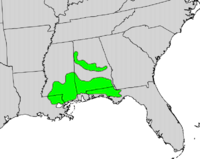Illicium floridanum
| Illicium floridanum | |
|---|---|
 | |
| Scientific classification | |
| Kingdom: | Plantae |
| Clade: | Angiosperms |
| Order: | Austrobaileyales |
| Family: | Schisandraceae |
| Genus: | Illicium |
| Species: | I. floridanum |
| Binomial name | |
| Illicium floridanum J.Ellis | |
.jpg)
Illicium floridanum (also known as purple anise, Florida anise, stink-bush, or star-anise) is an evergreen shrub native to the south-eastern United States especially Florida and Louisiana.[1]
Description
The Florida anise tree has large evergreen lance shaped leaves that are lustrous and dark green.[2] When crushed the leaf has a sweet odor, described as being "anise-like".[3] The leaf of this plant can also be observed as having a parallel main vein.[4] Within the leaf of this shrub, a flower also grows. The flower has 20-30 maroon colored petals. The petals are measured to be 2 inches in diameter.[5] The flower is attractive, and it is often overlooked within the lush shiny foliage. The flower is said to have a fish-like odor. If the flower is ripe, the seed explodes out of the star- shaped fruit.This plant has a variety that can be produced in cultivation through selective breeding. Depending on the breeding, white flowers can be observed. When the flower of the Illicium Floridanum plant is fully expanded, it can be described as being the size of a dollar.[6]
Taxonomy
The illicium Floridanum plant was first discovered in 1765 by the servant of a man named William Clifton, Esq. of West Florida. It was first observed growing in a swamp near Pensacola. In 1766, the king's botanist , John Bartram found the Illicium Flordianum plant on the St. John River bank located in East Florida. He made a drawing of the plant, where he described the petals, leaves, and type of tree.[7]
Distribution
This perennial plant is found in northern Florida and Georgia as well as, along the coastal plain toward Louisiana. The Illicium Floridanum plant is endangered in Georgia.[8] This plant species in those areas are known to be toxic.[9] The Illicium Floridanum shrub can be seen growing in wetlands, but can also be found in non-wetland areas. It grows in partial to fully shaded areas. However, it can survive in sunny areas, as long as it is being watered well. The soil for this plant should be moist, mulched and watered, especially during periods of dryness.[10]
Uses
This plant should not be ingested , it is not considered an alternative to a culinary spice. However, there is a similar plant species to the illicium Floridanum; the Chinese plant known as illicium verum,[11] which is used for spices and medicine.

References
- ↑ "Illicium foridanum". Floridata. Retrieved 2013-06-28.
- ↑ "Illicium floridanum Plant Profile". Retrieved 2016-12-06.
- ↑ "Illicium floridanum Plant Profile". Retrieved 2016-12-06.
- ↑ "Illicium floridanum. Starry Anise. | Henriette's Herbal Homepage". www.henriettes-herb.com. Retrieved 2016-12-06.
- ↑ "Illicium floridanum Plant Profile". Retrieved 2016-12-06.
- ↑ "Illicium floridanum. Starry Anise. | Henriette's Herbal Homepage". www.henriettes-herb.com. Retrieved 2016-12-06.
- ↑ "Illicium floridanum. Starry Anise. | Henriette's Herbal Homepage". www.henriettes-herb.com. Retrieved 2016-12-06.
- ↑ "Plants Profile for Illicium floridanum (Florida anisetree)". plants.usda.gov. Retrieved 2016-12-06.
- ↑ "Illicium floridanum Plant Profile". Retrieved 2016-12-06.
- ↑ "Plants Profile for Illicium floridanum (Florida anisetree)". plants.usda.gov. Retrieved 2016-12-06.
- ↑ "Illicium floridanum Plant Profile".
| Wikimedia Commons has media related to Illicium floridanum. |